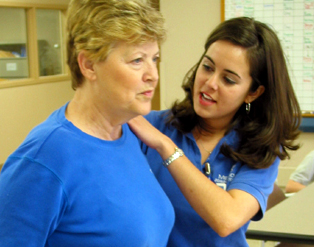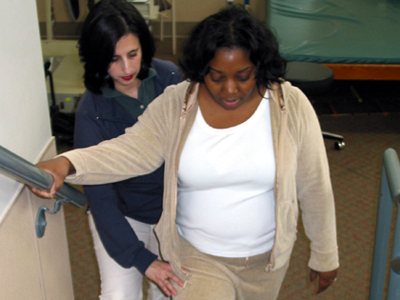Jackson, Miss.—LaKeysha Greer easily could have ignored the tingling in her toes and fingers.
But the Jackson lawyer decided to visit the emergency room before leaving on a business trip to Austin, Texas. And she’s ever so glad she did. Otherwise, she might have been aboard a plane when the “weird feeling” escalated into a paralyzing case of Guillain-Barre’ Syndrome (GBS).
The neurological disorder strikes only about one or two people per 100,000. So Greer was surprised to find she is among six patients at Methodist Rehabilitation Center now recovering from the rare disease.
GBS occurs when the body’s immune system attacks myelin, the insulation that surrounds and protects nerve fibers, said neurologist Art Leis, a senior scientist at the Jackson hospital’s Center for Neuroscience and Neurological Recovery. The resulting damage leaves the nerves like frayed telephone wires and temporarily disconnects communication between the brain and muscles.
“Most patients initially complain of loss of sensation or weakness in their feet,” Dr. Leis said. The numbness generally moves upward from the extremities. In the worst cases, victims become completely paralyzed and must rely on ventilators to breathe.
Leis said about half of GBS cases are triggered by some type of viral or bacterial infection. “Typically it’s an upper respiratory infection, but it also can be gastrointestinal,” he said. “Some cases of gastrointestinal infection have been linked to Campylobacter, a bacteria found in undercooked foods such as poultry.”
Other risk factors associated with GBS include vaccinations, stress and surgery. People who have compromised immune systems because of conditions such as HIV or West Nile virus also may be more susceptible to the syndrome.
Leis said he’s not sure if the cluster of patients at Methodist reflects a rise in GBS following Hurricane Katrina or is merely coincidental. But he says at least two of the cases do appear to have a hurricane connection.
Greer believes her illness was triggered by the hepatitis B, tetanus and diptheria vaccinations that she got in anticipation of volunteering on the Mississippi Gulf Coast. And June Gautier, a temporary Jackson resident, says her GBS may be the result of the tetanus and flu shots she received before heading to Long Beach to inspect her hurricane-ravaged home.
While the CDC says less than 1 percent of GBS cases have been linked to vaccinations, a cluster of GBS was associated with the Swine Flu vaccine of 1976. And as recently as September, the Food and Drug Administration alerted health care providers to five reports of the syndrome among teenagers receiving certain meningococcal vaccines.
Nevertheless, Leis advises against using the threat of GBS as an excuse to skip necessary vaccinations. “The risk of developing GBS is minimal compared to the risk of developing the diseases that the vaccines prevent.”
He adds, however, that it is important to be aware of the connection and seek help if you have weakness, numbness, tingling or increased sensitivity following a vaccination.
Since Guillain-Barre’ can progress fairly rapidly to paralysis, support services can be critical.
According to the Centers for Disease Control, symptoms usually reach their peak by four weeks and more than 95 percent of GBS victims survive. While most patients recover functionally, about 20 percent are left with persistent symptoms.
Within 24 hours of her first symptoms, Greer’s limbs became limp and useless. She could lift her big toes, but not her feet; her fingers, but not her hands. “Then I got facial paralysis. I remember saying: I don’t want to be a prisoner in my own body.”
Greer, 31, grins wryly at the drama of that statement, but it was hardly hyperbole. Her body seemed stuck in some strange stupor, while her mind churned with worry. “The hardest part was not knowing. It took a week and a half before they figured out what it was.”
Gautier said she visited a local clinic when her symptoms first began and was told she probably had arthritis. Hours later, the 66-year-old was headed to the hospital by ambulance. “My legs and arms wouldn’t work so the EMTs had to come get me. I thought I had Mad Cow Disease because I had fallen like those cows on TV.”
Leis said it’s not unusual for GBS to be mistaken for other illnesses. “Early on, clinical symptoms can mimic other diagnoses. That’s why it’s important to consider GBS when patients complain of weakness and numbness that starts in the hands and feet and ascends to include the whole body -- especially if these symptoms occur a few weeks after vaccinations or an upper respiratory or gastrointestinal illness.”
GBS can be confirmed by analyzing spinal fluid for evidence of elevated protein levels and conducting electrodiagnostic studies to examine nerve and muscle function. To treat Guillain-Barre’, doctors often prescribe immunoglobulin therapy or plasmapheresis, a process that removes disease-provoking components from the blood.
Leis said such treatments can prevent damage to the nerve fibers, and facilitate a better outcome. “In many cases, if only the myelin is damaged, recovery is excellent. But if the nerve fibers themselves are damaged, recovery can be slow and incomplete.”
Leis said extensive physical and occupational therapy also is critical. And as Mississippi’s only hospital that specializes in rehabilitation medicine, Methodist attracts GBS patients from across the state. Since January of 2000, 26 have come to Methodist to recover from the syndrome’s debilitating effects.
Greer says she began her therapy wondering whether she could keep up. “I knew I would be in therapy several hours a day and I didn’t know if I would be able to do it. I couldn’t walk or stand. But after the first week, I started feeling a lot stronger.”
Greer quickly progressed from wheelchair to walker to cane, and she continues to improve, said Lisa Indest, a physical therapist at Methodist’s outpatient clinic in Flowood. “Her return has been phenomenal,” Indest said. “Hand function is usually a big problem for people with Guillain-Barre’, but she is back using her computer.”
Greer has returned to work part-time at Cosmich and Simmons in Jackson, but she confides that she still has problems with stamina and endurance. “I feel like I can do most anything – just not for a long time,” she says with a grin.
Nevertheless, she’s proud to be serving as a role model for the Guillain-Barre’ patients at Methodist who are just beginning the rehab process. “It was inspiring to me when I would hear about a person who had it and recovered fully,” she said.


